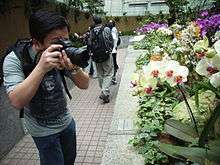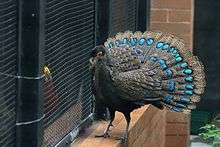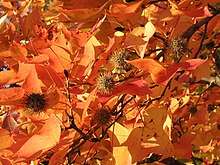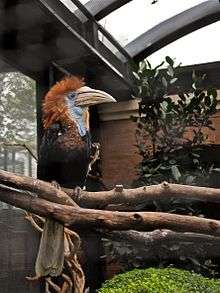Hong Kong Zoological and Botanical Gardens
The Hong Kong Zoological and Botanical Gardens (Chinese: 香港動植物公園) is one of the oldest zoological and botanical centres in the world. It occupies an area of 5.6 hectares (14 acres) at Mid-levels, on the northern slope of Victoria Peak in Hong Kong. Founded in 1864, its first stage had been opened to the public in 1871.[1] It is the oldest park in Hong Kong.[2]
Memorial Gate for British Chinese Soldiers | |
| Date opened | 1871 |
|---|---|
| Location | Mid-levels, Victoria Peak, Hong Kong |
| Coordinates | 22°16′40.03″N 114°9′22.70″E |
| Land area | 5.6 Acres |
| No. of animals | 700+ |
| Website | www.lcsd.gov.hk/parks/hkzbg/en/index.php |
| Hong Kong Zoological and Botanical Gardens | |||||||||||
|---|---|---|---|---|---|---|---|---|---|---|---|
| Traditional Chinese | 香港動植物公園 | ||||||||||
| Simplified Chinese | 香港动植物公园 | ||||||||||
| |||||||||||
Similar to Hong Kong Park, Hong Kong Zoological and Botanical Gardens provides a natural environment and atmosphere in Central District. It is bigger than Hong Kong Park and contains more plants, birds and facilities.
History

The park was previously named Bing Tau Fa Yuen (「兵頭花園」).[1] "Bing Tau" literally means "the head of the soldiers" or the "Commander-in-Chief". According to Hong Kong's Leisure and Cultural Services Department, it was nicknamed as such by the city's Chinese community, as it was the former site of the city's Government House.[3] Others said Bing Tau was just the phonetic transliteration of the first two syllables of the word botanical. In the old days, many lovers liked to go there on a date. During the Japanese occupation, it was renamed as Taishō Kōen (Hiragana:たいしょうこうえん, Kanji: 大正公園).
Memorials

At the southern entrance to the gardens, at Upper Albert Road, is a memorial arch dedicated to the Chinese who died assisting the Allies during the two world wars. The inscription on the lintel reads: "In Memory of the Chinese who died loyal to the Allied cause in the Wars of 1914-1918 and 1939-1945". The granite arch in the shape of a paifang was erected in 1928. Reference to the Second World War was added later.[4]
A bronze statue of King George VI was erected in commemoration of the 100th anniversary of British colonial rule over Hong Kong (1841–1941).[5]
Plants
There are more than 1,000 species of plants in the gardens,[6] mostly indigenous to tropical and sub-tropical regions. It includes some rare species like the dawn redwood and the local Ailanthus. Besides these, some species which can produce flowers throughout the year can also be found there, like the Hong Kong orchid tree.
Different Species are grown in the Thematic gardens in the Hong Kong Zoological and Botanical Gardens.
Bamboo Garden
This garden grows about ten times bigger than other gardens.
Camellia Garden
More than 30 species are grown in this garden. Crapnell's camellia (Camellia crapnelliana), Grantham's camellia (Camellia granthamiana) and Hong Kong camellia (Camellia hongkongensis) are native to Hong Kong.
Some introduced rare species such as Yunnan camellia (Camellia reticulata) and golden camellia (Camellia nitidissima and Camellia euphlebia) can also be found in this garden.
Magnolia Garden
This garden grows 5 species of magnolia:
- Chinese magnolia (Magnolia coco)
- Yulan (magnolia denudata)
- Purple magnolia (Magnolia liliiflora)
- Saucer magnolia (Magnolia × soulangeana)
- Southern magnolia (Magnolia grandiflora).
Greenhouse

Various species of orchids, ferns, bromeliads, vines and carnivorous plants are grown in the greenhouse.
Palm Garden
This garden grows over 30 species under 22 genera of the palm family.
Bauhinia Garden
This garden grows 8 species including Hong Kong orchid tree (Bauhinia blakeana), purple camel's foot (Bauhinia purpurea) and camel's foot tree (Bauhinia variegata).
Azalea Garden
This garden grows over 10 azalea species including red azalea (Rhododendron simsii), lovely azalea (Rhododendron pulchrum), purple azalea (Rhododendron pulchrum var. phoeniceum) and white azalea (Rhododendron mucronatum), those are native to Hong Kong. There are also rare species such as yellow azalea (Rhododendron molle) and Westland's rhododendron (Rhododendron moulmainense).
Herb Garden
Various species of herb are grown in the garden.
Animals
The size of the garden precludes the keeping of very large mammal species such as giraffes. Nevertheless, the collection of primates is varied, including such diverse creatures such as the golden lion tamarin, gibbon, orangutan, ring-tailed lemur and black-and-white ruffed lemur. Apart from the plants, there are over 400 birds, 50 mammals and 20 reptiles.
Mammals and reptiles
A taxidermy specimen of Siu Fa, the female jaguar that lived in Hong Kong for nearly 20 years is on display at the Education and Exhibition Centre of HKZBG from March 5 2009.[7]
A pigeon pair of Bornean orangutan twins were born in the HKZBG in July 2011, joining the big family of the gardens. This is the first-ever successful breeding of Bornean orangutan twins in the HKZBG, bringing to five the total number of this primate in the gardens[8]
To enhance public understanding and appreciation of all living creatures, the two female meerkats introduced to the HKZBG are aged 4 and 5 and are housed in the newly decorated "Meerkat's Home".[9]
The reptiles are primarily snakes and turtles such as the African spurred tortoise, Chinese alligator and Burmese python.
Birds

Over 100 species have successfully reared young including Red-crowned crane, peacock pheasant and Rothschild's Mynah all of which are highly endangered in the wild.
An injury Black-faced Spoonbill was rescued in Nam Sang Wai by staff of the Agriculture, Fisheries and Conservation Department and transferred to the KFBG Wild Animal Rescue Centre in March 2018. This Black-faced Spoonbill which was unable to fly after the operation. Fortunately it will be able to join other water birds at HKZBG and so will have companions in captivity.[10]
The small brick buildings that house some of the smaller birds were once staff quarters for Chinese workers at the park. These were recently renovated, resulting in the destruction of a row of disused Victorian gas lamp posts, probably the last remaining such row in Hong Kong, and possibly in East Asia.
Animal welfare concerns
The Hong Kong zoo has come under "fire for 'outdated' facilities"[11] and inadequate, overcrowded conditions for the animals housed within its confines.
The South China Morning Post reported the Kadoorie Institute, the SPCA, Animals Asia and Orangutanaid "expressed sincere doubts over the welfare of its animals and recommended that the park be returned to its original status as a botanical garden".[12] Later in the year, Jane Goodall expressed her "concern over the treatment of orangutans in Hong Kong's zoo" saying that they "were not in a good situation", and adding that "large animals in small cages with nothing to do are not happy animals".[13]
Transport
The main entrance is located at Upper Albert Road. A number of bus routes give access to the facility.[14] Admission is free to all parts of the Zoological and Botanical Gardens.
See also
- Central and Western Heritage Trail
- King George V Memorial Park, Hong Kong
- List of urban public parks and gardens of Hong Kong
References
- HKZBG website: Background Archived 2008-12-26 at the Wayback Machine
- "Hong Kong Zoological and Botanical Gardens | Hong Kong Tourism Board". www.discoverhongkong.com. Retrieved 2017-08-08.
- "Hong Kong Zoological and Botanical Gardens - Introduction". Leisure and Cultural Services Department. Retrieved 3 February 2018.
- Lau, Ka-fai, Joseph, "Planning of interpretation strategy for Chinese style : 'Pai-type portal structure' before 1941 on Hong Kong Island" Archived 2011-10-05 at the Wayback Machine, Dissertation, University of Hong Kong, September 2005
- The Film Services Office: Hong Kong Zoological and Botanical Gardens
- "HKZBG website: Plants". Archived from the original on 2011-07-16. Retrieved 2011-07-11.
- Jaguar Siu Fa's specimen goes on display at HKZBG https://www.info.gov.hk/gia/general/200903/05/P200903050142.htm
- "First Bornean orangutan twins born in Hong Kong Zoological and Botanical Gardens" https://www.info.gov.hk/gia/general/201107/12/P201107120215.htm
- Meerkats join Hong Kong Zoological and Botanical Gardens family https://www.info.gov.hk/gia/general/201612/23/P2016122300323.htm
- Facebook article:"Rescued Black-faced Spoonbill Rehomed to Zoological and Botanical Gardens in Hong Kong"
- "Hong Kong zoo under fire for". South China Morning Post. Retrieved 2015-10-29.
- "Small cages and nothing to do: Hong Kong Zoo animals 'trapped in the 19th century'". South China Morning Post. This article appeared in the South China Morning Post print edition as Zoo's animals are 'trapped in 19th century'. Retrieved 2015-10-29.CS1 maint: others (link)
- "Jane Goodall slams orang-utan conditions at city zoo". South China Morning Post. Retrieved 2015-10-29.
- "How to Access". Leisure & Cultural Services Department. Archived from the original on 2014-02-06. Retrieved 2014-02-12.
External links
| Wikimedia Commons has media related to Hong Kong Zoological and Botanical Gardens. |

